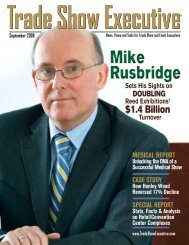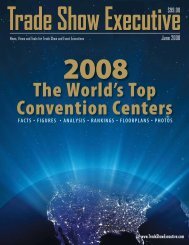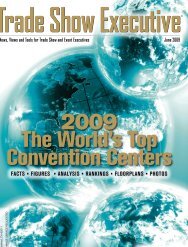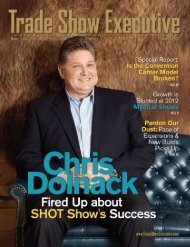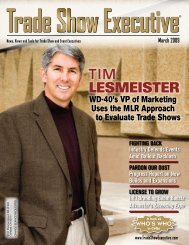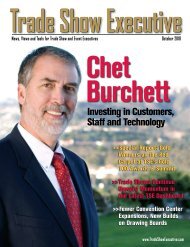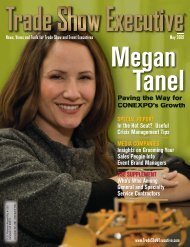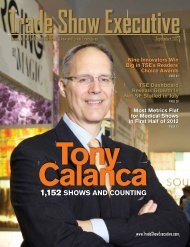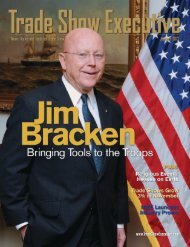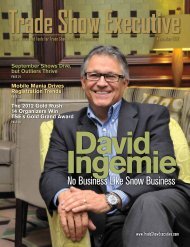the April 2009 Issue in PDF Format - Trade Show Executive
the April 2009 Issue in PDF Format - Trade Show Executive
the April 2009 Issue in PDF Format - Trade Show Executive
Create successful ePaper yourself
Turn your PDF publications into a flip-book with our unique Google optimized e-Paper software.
T r e n d i n g & S p e n d i n g<br />
Economic Woes and Bailout<br />
Backlash Hit <strong>Trade</strong> <strong>Show</strong><br />
Industry Hard<br />
Darlene Gudea,<br />
VP/publisher & editor<br />
<strong>Trade</strong> <strong>Show</strong> <strong>Executive</strong>’s<br />
Trend<strong>in</strong>g & Spend<strong>in</strong>g Forecast<br />
Fig. I: TSE Forecast of<br />
Net Square Feet of Exhibit Space<br />
12.0%<br />
2nd Quarter<br />
Fig. II: TSE Forecast of Number<br />
of Exhibit<strong>in</strong>g Organizations<br />
9.0%<br />
2nd Quarter<br />
11.5%<br />
<strong>2009</strong><br />
9.0%<br />
<strong>2009</strong><br />
Fig. IlI: TSE Forecast of<br />
Professional Attendance<br />
20.0%<br />
2nd Quarter<br />
12.0% May<br />
10.0% May<br />
20.0% May<br />
18.4%<br />
<strong>2009</strong><br />
Fig. lV: TSE Annual Forecast<br />
of Revenue<br />
14.0%<br />
Frank Chow,<br />
chief economist<br />
Year End<strong>in</strong>g December <strong>2009</strong><br />
By Darlene Gudea,<br />
VP/publisher & editor<br />
Carlsbad, CA - With each successive<br />
stimulus or bailout plan, consumers’<br />
confidence has plunged to an<br />
unprecedented nadir. The Conference<br />
Board Consumer Confidence Index<br />
has decl<strong>in</strong>ed every month s<strong>in</strong>ce<br />
September 2008, fall<strong>in</strong>g moderately <strong>in</strong><br />
January to 37.4 and crash<strong>in</strong>g <strong>in</strong> February<br />
to 25, reach<strong>in</strong>g ano<strong>the</strong>r all-time low.<br />
The trend has been driven by worsen<strong>in</strong>g<br />
bus<strong>in</strong>ess expectations and a rapidly<br />
deteriorat<strong>in</strong>g job market. Moreover, <strong>the</strong><br />
massive $787 billion stimulus bill touted<br />
to save or create more than 3.5 million<br />
jobs is <strong>in</strong>creas<strong>in</strong>gly be<strong>in</strong>g perceived as<br />
more of a government spend<strong>in</strong>g bill<br />
that may not create significant new jobs<br />
until next year. Meanwhile, <strong>the</strong> average<br />
person cont<strong>in</strong>ues to hear about neighbors<br />
or colleagues los<strong>in</strong>g jobs. Also, recent<br />
government and media rhetoric from <strong>the</strong><br />
numerous bailout plans is caus<strong>in</strong>g some<br />
immediate fallout <strong>in</strong> employment directly<br />
related to <strong>the</strong> trade show <strong>in</strong>dustry.<br />
S<strong>in</strong>ce <strong>the</strong> recession began<br />
(December 2007), <strong>the</strong> economy has<br />
elim<strong>in</strong>ated roughly 4.4 million jobs,<br />
with more than half – 2.6 million –<br />
disappear<strong>in</strong>g <strong>in</strong> <strong>the</strong> last four months.<br />
This surpris<strong>in</strong>g decl<strong>in</strong>e fostered<br />
speculation that some <strong>in</strong>dustries are<br />
be<strong>in</strong>g partly dismantled, said Frank<br />
Chow, chief economist for <strong>Trade</strong> <strong>Show</strong><br />
<strong>Executive</strong>. Layoffs are multiply<strong>in</strong>g due<br />
to <strong>the</strong> collapse of <strong>the</strong> f<strong>in</strong>ancial system,<br />
prompt<strong>in</strong>g even healthy companies to<br />
shed workers and shut down operations<br />
out of concern <strong>the</strong>y may soon lose<br />
access to credit. Borrow<strong>in</strong>g costs have<br />
spiked for American companies, mak<strong>in</strong>g<br />
bus<strong>in</strong>esses reluctant to expand and<br />
hire. “There was a huge <strong>in</strong>crease <strong>in</strong><br />
uncerta<strong>in</strong>ty and a huge hit to confidence<br />
which caused a large reth<strong>in</strong>k<strong>in</strong>g among<br />
bus<strong>in</strong>esses,” said Ethan Harris, codirector<br />
of U.S. economics research at<br />
Barclays Capital.<br />
When Department of Labor<br />
data revealed that 651,000 more jobs<br />
disappeared <strong>in</strong> February, a sense<br />
emerged that escalat<strong>in</strong>g joblessness<br />
may reflect a wrench<strong>in</strong>g restructur<strong>in</strong>g<br />
of <strong>the</strong> economy, Chow said. The<br />
unemployment rate surged to 8.1% <strong>in</strong><br />
February – its highest level <strong>in</strong> 25 years.<br />
In key <strong>in</strong>dustries – manufactur<strong>in</strong>g,<br />
f<strong>in</strong>ancial services and retail – layoffs<br />
have accelerated so quickly it suggests<br />
many companies are just abandon<strong>in</strong>g<br />
whole areas of bus<strong>in</strong>ess, said Chow.<br />
“The current pace of decl<strong>in</strong>e is<br />
breathtak<strong>in</strong>g,” said Robert Barbera,<br />
chief economist at <strong>the</strong> research and<br />
trad<strong>in</strong>g firm ITG.<br />
Keith Hall, Bureau of Labor Statistics<br />
commissioner, testify<strong>in</strong>g before Congress<br />
about <strong>the</strong> recent monthly job losses<br />
said, “… just to put it <strong>in</strong>to perspective,<br />
we’ve only had maybe ten months where<br />
we’ve lost 500,000 jobs or more <strong>in</strong> <strong>the</strong><br />
history of our series s<strong>in</strong>ce 1940. This<br />
is four of <strong>the</strong> ten, all <strong>in</strong> a row.” While<br />
past recessions have proven that most<br />
lost jobs will not return, o<strong>the</strong>r <strong>in</strong>dustries<br />
usually emerge to create jobs when<br />
economic growth resumes.<br />
However, some economists doubt<br />
this will be <strong>the</strong> case this time. “These<br />
jobs aren’t com<strong>in</strong>g back,” said John<br />
Silvia, chief economist at Wachovia. “A<br />
lot of production ei<strong>the</strong>r isn’t go<strong>in</strong>g to<br />
happen at all, or it’s go<strong>in</strong>g to happen<br />
somewhere o<strong>the</strong>r than <strong>the</strong> United States.<br />
There are go<strong>in</strong>g to be fewer stores,<br />
fewer factories, fewer f<strong>in</strong>ancial services<br />
operations. Firms are mak<strong>in</strong>g strategic<br />
decisions that <strong>the</strong>y don’t want to be <strong>in</strong><br />
<strong>the</strong>ir bus<strong>in</strong>esses.”<br />
Much of <strong>the</strong> job losses are at legacy<br />
American brands. Here is a list from 2008<br />
16 <strong>April</strong> <strong>2009</strong> <strong>Trade</strong> <strong>Show</strong> <strong>Executive</strong> www.<strong>Trade</strong><strong>Show</strong><strong>Executive</strong>.com



